What 3 Countries Makeup The Caucasans Region

Try our email course on U.S. clearing
Acquire virtually U.S. immigration through 5 short lessons delivered to your inbox every other 24-hour interval.
Sign upwardly now!
At its cadre, census is the act of counting people. But it'south also important to report the forces that are driving population change, and measure out how these changes have an impact on people's lives. For example, how does immigration affect U.S. population growth? Do Americans feel that children are ameliorate off with a parent at home, in an era when most women work? How is the ascent of the immature-adult Millennial generation contributing to the rise of Americans with no stated religion? For this yr'south Population Association of America (PAA) annual meeting, here is a roundup of some of Pew Research Center'southward recent demography-related findings that tell the states how America and the globe are changing.
1 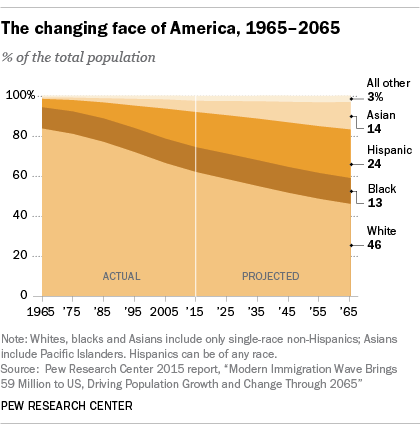 Americans are more racially and ethnically diverse than in the past, and the U.S. is projected to be even more diverse in the coming decades. By 2055, the U.S. volition not have a single racial or ethnic bulk. Much of this change has been (and will be) driven by immigration. Nearly 59 million immigrants have arrived in the U.Due south. in the by 50 years, generally from Latin America and Asia. Today, a near-tape 14% of the country's population is foreign born compared with just 5% in 1965. Over the next five decades, the majority of U.Southward. population growth is projected to exist linked to new Asian and Hispanic immigration. American attitudes nearly immigration and diverseness are supportive of these changes for the most part. More Americans say immigrants strengthen the land than say they brunt it, and most say the U.S.'due south increasing ethnic diversity makes it a better place to alive.
Americans are more racially and ethnically diverse than in the past, and the U.S. is projected to be even more diverse in the coming decades. By 2055, the U.S. volition not have a single racial or ethnic bulk. Much of this change has been (and will be) driven by immigration. Nearly 59 million immigrants have arrived in the U.Due south. in the by 50 years, generally from Latin America and Asia. Today, a near-tape 14% of the country's population is foreign born compared with just 5% in 1965. Over the next five decades, the majority of U.Southward. population growth is projected to exist linked to new Asian and Hispanic immigration. American attitudes nearly immigration and diverseness are supportive of these changes for the most part. More Americans say immigrants strengthen the land than say they brunt it, and most say the U.S.'due south increasing ethnic diversity makes it a better place to alive.
2 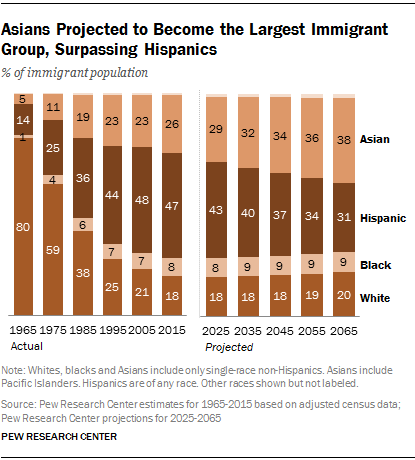 Asia has replaced Latin America (including Mexico) every bit the biggest source of new immigrants to the U.S. In a reversal of one of the largest mass migrations in modern history, net migration flows from United mexican states to the U.S. turned negative between 2009 and 2014, every bit more than Mexicans went abode than arrived in the U.S. And subsequently rising steadily since 1990, the unauthorized immigrant population has leveled off in recent years, falling to 11.three million in 2014 from a high of 12.2 million in 2007. Meanwhile, Asians are now the just major racial or ethnic group whose numbers are rising mainly considering of clearing. And while African immigrants make up a small share of the U.S. immigrant population, their numbers are also growing steadily – roughly doubling every decade since 1970.
Asia has replaced Latin America (including Mexico) every bit the biggest source of new immigrants to the U.S. In a reversal of one of the largest mass migrations in modern history, net migration flows from United mexican states to the U.S. turned negative between 2009 and 2014, every bit more than Mexicans went abode than arrived in the U.S. And subsequently rising steadily since 1990, the unauthorized immigrant population has leveled off in recent years, falling to 11.three million in 2014 from a high of 12.2 million in 2007. Meanwhile, Asians are now the just major racial or ethnic group whose numbers are rising mainly considering of clearing. And while African immigrants make up a small share of the U.S. immigrant population, their numbers are also growing steadily – roughly doubling every decade since 1970.
3 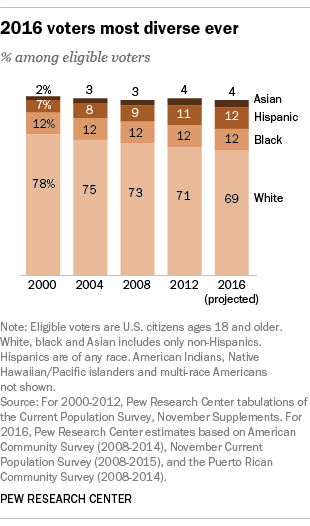 America'due south demographic changes are shifting the electorate – and American politics. The 2016 electorate will be the nearly diverse in U.S. history due to strong growth among Hispanic eligible voters, particularly U.S.-born youth. There are also broad gaps opening up between the generations on many social and political issues. Young adult Millennials are much more than likely than their elders to hold liberal views on many political and social issues, though they are also less likely to identify with either political political party: fifty% call themselves political independents.
America'due south demographic changes are shifting the electorate – and American politics. The 2016 electorate will be the nearly diverse in U.S. history due to strong growth among Hispanic eligible voters, particularly U.S.-born youth. There are also broad gaps opening up between the generations on many social and political issues. Young adult Millennials are much more than likely than their elders to hold liberal views on many political and social issues, though they are also less likely to identify with either political political party: fifty% call themselves political independents.
iv Millennials, young adults born from 1981 to 1996, are the new generation to sentinel. By 2019 they will surpass Baby Boomers (born 1946-1964) as the largest U.Due south. developed generation, and they differ significantly from their elders in many ways. They are the most racially diverse developed generation in American history: 43% of Millennials are nonwhite, the highest share of any generation. And while they are on rail to be the most educated generation to date, this accomplishment has come up at a cost: Many Millennials are struggling with pupil debt. In add-on to the weak labor market of recent years, student debt is perhaps ane reason why many are still living at habitation. Despite these troubles, Millennials are the most upbeat nigh their financial time to come: More than eight-in-ten say they either currently have plenty money to lead the lives they desire or expect to in the future.
Note: Item No. 4 in this mail service was updated on March 23, 2018, to reflect the Center'due south revised definition of the Millennial generation and the updated year in which Millennials volition be the largest generation.
5 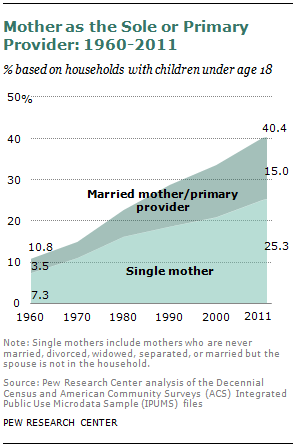 Women's role in the labor force and leadership positions has grown dramatically. The labor force participation rate for American women has risen steadily since the 1960s. In fact, mothers were the sole or master breadwinner in a record 40% of all households with children in 2011. The gender pay gap has narrowed over this period of time, especially for young women just entering the labor force, simply it still persists. As more women take entered the workforce, the share of women in top leadership jobs has risen, but they even so make up a small share of the nation's political and business concern leaders relative to men. Why the continued disparity? While Americans say women are equally as capable of existence good leaders every bit men, four-in-10 believe they are held to college standards than men and that the U.S. is just not ready to put more women in acme leadership positions.
Women's role in the labor force and leadership positions has grown dramatically. The labor force participation rate for American women has risen steadily since the 1960s. In fact, mothers were the sole or master breadwinner in a record 40% of all households with children in 2011. The gender pay gap has narrowed over this period of time, especially for young women just entering the labor force, simply it still persists. As more women take entered the workforce, the share of women in top leadership jobs has risen, but they even so make up a small share of the nation's political and business concern leaders relative to men. Why the continued disparity? While Americans say women are equally as capable of existence good leaders every bit men, four-in-10 believe they are held to college standards than men and that the U.S. is just not ready to put more women in acme leadership positions.
half-dozen 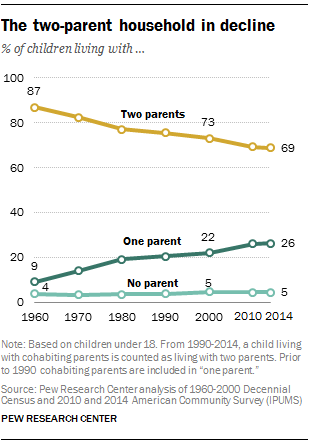 The American family unit is changing. Later on decades of declining spousal relationship rates, the share of American adults who have never been married is at an historic high. Ii-parent households are on the decline in the U.S., while divorce, remarriage and cohabitation are on the ascension. Nearly one-in-half-dozen American kids now live in a blended family. And the roles of mothers and fathers are converging, due in function to the rise of breadwinner moms. Dads are doing more housework and child care, while moms are doing more than paid work outside the domicile. Americans are conflicted nigh some aspects of this modify: While nearly half of two-parent households take a mom and dad who both work full fourth dimension, 51% of Americans say children are better off with a female parent at abode.
The American family unit is changing. Later on decades of declining spousal relationship rates, the share of American adults who have never been married is at an historic high. Ii-parent households are on the decline in the U.S., while divorce, remarriage and cohabitation are on the ascension. Nearly one-in-half-dozen American kids now live in a blended family. And the roles of mothers and fathers are converging, due in function to the rise of breadwinner moms. Dads are doing more housework and child care, while moms are doing more than paid work outside the domicile. Americans are conflicted nigh some aspects of this modify: While nearly half of two-parent households take a mom and dad who both work full fourth dimension, 51% of Americans say children are better off with a female parent at abode.
sevenThe share of Americans who live in middle class households is shrinking. The share of U.Due south. adults living in middle-income households fell to 50% in 2015, after more than four decades in which those households served as the nation's economic majority. And the financial gaps between middle- and upper-income Americans have widened, with upper-income households holding 49% of U.South. aggregate household income (up from 29% in 1970) and seven times as much wealth as middle-income households (upward from three times as much in 1983). Well-nigh Americans say the government doesn't do enough to aid the middle form, and neither political party is widely viewed as a champion for middle-form interests.
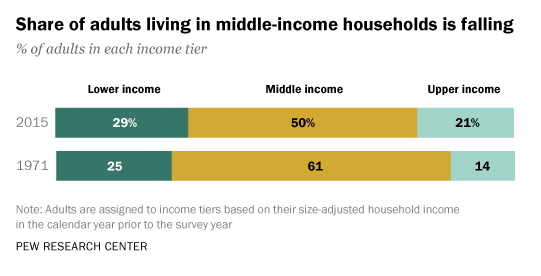
viiiChristians are declining as a share of the U.S. population, and the number of U.S. adults who do not place with any religion has grown. While the U.S. remains home to more Christians than any other state, the percentage of Americans identifying as Christian dropped from 78% in 2007 to 71% in 2014. By contrast, the religiously unaffiliated have surged seven percentage points in that time span to make up 23% of U.South. adults terminal year. This trend has been driven in large part by Millennials, 35% of whom are religious "nones." The rise of the "nones" is not a story unique to the U.Southward.: The unaffiliated are now the 2nd-largest religious group in 48% of the world'due south nations. Americans are well aware of this shift: 72% say religion's influence on public life is waning, and most who say this meet information technology as a bad thing.
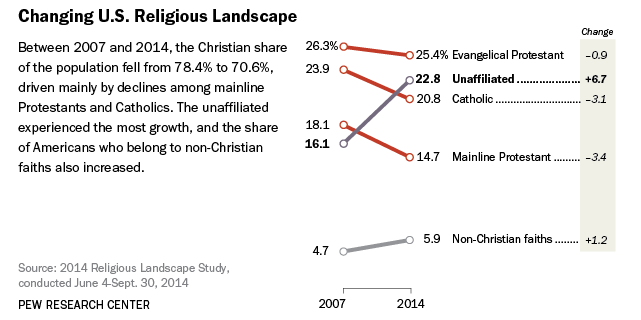
ixThe world's religious makeup will expect a lot dissimilar by 2050: Over the next four decades, Christians will remain the largest religious group, just Islam will abound faster than any other major religion, more often than not because Muslims are younger and have more children than any other religious group globally. By 2050, the number of Muslims volition most equal the number of Christians. In the U.Southward., the Muslim population will remain small, merely is projected to abound rapidly.
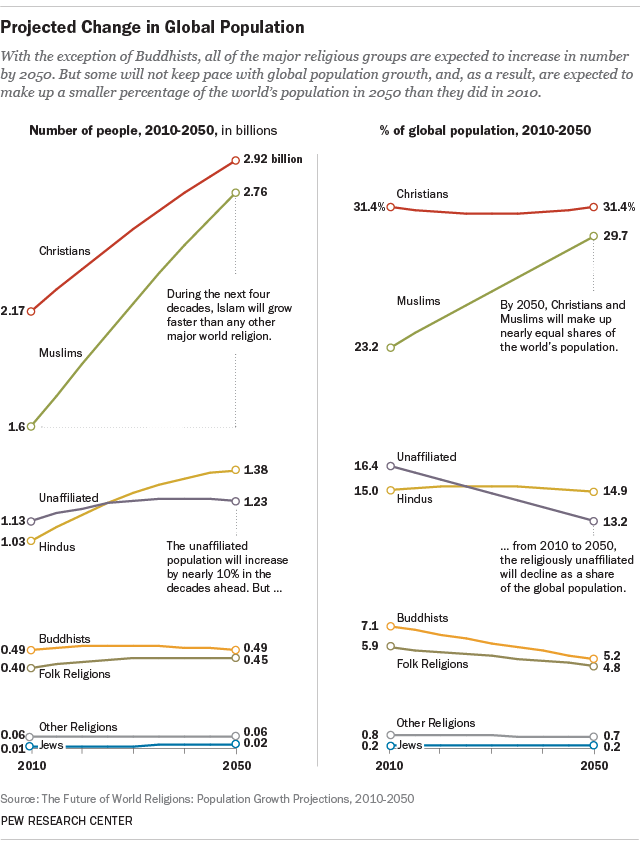
10The world is crumbling. The demographic futurity for the U.S. and the globe looks very different than the recent past. Growth from 1950 to 2010 was rapid — the global population about tripled, and the U.S. population doubled. However, population growth from 2010 to 2050 is projected to be significantly slower and is expected to tilt strongly to the oldest age groups, both globally and in the U.S. Public opinion on whether the growing number of older people is a trouble varies dramatically around the world. Concern is highest in Eastern asia where large majorities describe aging as a major trouble for their countries.
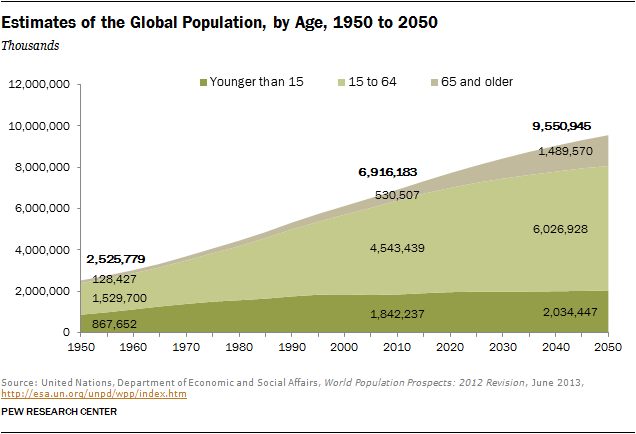
Note: Detail No. 4 in this post was updated on March 23, 2018.
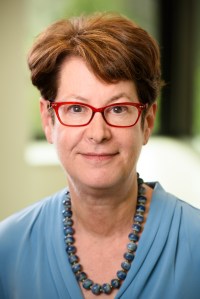
D'Vera Cohn is a senior writer/editor focusing on immigration and demographics at Pew Research Center.

Andrea Caumont is the digital appointment managing director at Pew Research Center.
What 3 Countries Makeup The Caucasans Region,
Source: https://www.pewresearch.org/fact-tank/2016/03/31/10-demographic-trends-that-are-shaping-the-u-s-and-the-world/
Posted by: julianfrowleall.blogspot.com


0 Response to "What 3 Countries Makeup The Caucasans Region"
Post a Comment